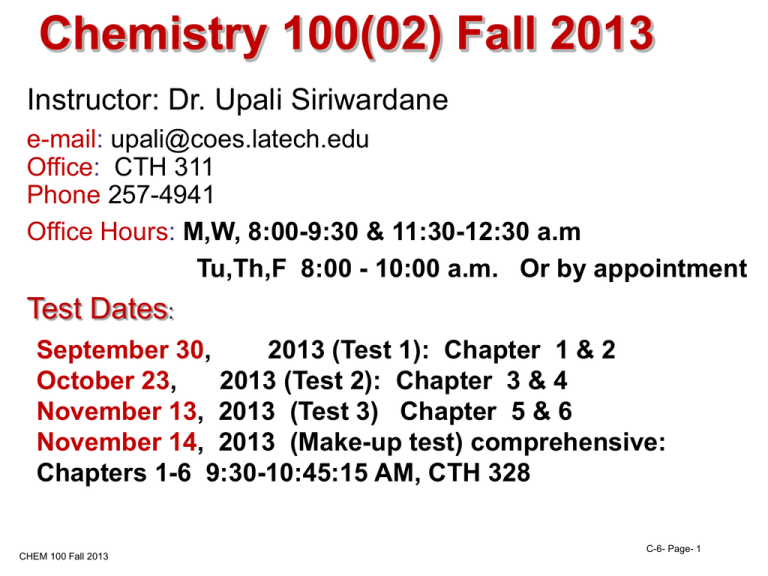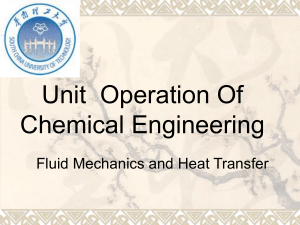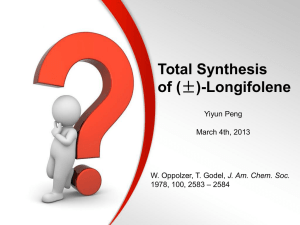
Chemistry 100(02) Fall 2013
Instructor: Dr. Upali Siriwardane
e-mail: upali@coes.latech.edu
Office: CTH 311
Phone 257-4941
Office Hours: M,W, 8:00-9:30 & 11:30-12:30 a.m
Tu,Th,F 8:00 - 10:00 a.m. Or by appointment
Test Dates:
September 30,
2013 (Test 1): Chapter 1 & 2
October 23,
2013 (Test 2): Chapter 3 & 4
November 13, 2013 (Test 3) Chapter 5 & 6
November 14, 2013 (Make-up test) comprehensive:
Chapters 1-6 9:30-10:45:15 AM, CTH 328
CHEM 100 Fall 2013
C-6- Page- 1
Text Book & Resources
REQUIRED :
Textbook: Principles of Chemistry: A Molecular Approach, 2nd
Edition-Nivaldo J. Tro - Pearson Prentice Hall and also purchase
the Mastering Chemistry
Group Homework, Slides and Exam review guides and sample
exam questions are available online: http://moodle.latech.edu/
and follow the course information links.
OPTIONAL :
Study Guide: Chemistry: A Molecular Approach, 2nd EditionNivaldo J. Tro 2nd Edition
Student Solutions Manual: Chemistry: A Molecular Approach, 2nd
Edition-Nivaldo J. Tro 2nd
Chapter 5. Gases
6.1 Chemical Hand Warmers…………………………………………………………………..231
6.2 The Nature of Energy: Key Definitions…………………………………………………...232
6.3 The First Law of Thermodynamics: There Is No Free Lunch…………………………….234
6.4 Quantifying Heat and Work……………………………………………………………….240
6.5 Measuring for Chemical Reactions: Constant-Volume Calorimetry……………………...246
6.6 Enthalpy: The Heat Evolved in a Chemical Reaction at Constant Pressure ……………..249
6.7 Constant-Pressure Calorimetry: Measuring……………………………………………….253
6.8 Relationships Involving……………………………………………………………………255
6.9 Determining Enthalpies of Reaction from Standard Enthalpies of Formation……………257
6.1 0 Energy Use and the Environment……………………………………………………….263
CHEM 100 Fall 2013
C-6- Page- 3
Chapter 6. KEY CONCEPTS: Thermochemistry
•Kinetic energy and potential energy
•Energy units and unit conversion
•Conservation of energy: heat and
work
•Thermodynamic terms: system,
surroundings, thermal equilibrium,
exothermic, endothermic, and state
function
•Heat capacity and calorimetry
•Internal energy and enthalpy
Thermochemical equations
Thermostoichiometric factors
CHEM 100 Fall 2013
•Standard enthalpy change for a
reaction, DHo
•Enthalpy change from bond
enthalpies
•Calorimetry and thermal energy
transferred during a reaction
•Hess's law and enthalpy
•Standard molar enthalpies of
formation DHo of a reaction.
•Chemical fuels and heating
•Main components of food
•Caloric intake
C-6- Page- 4
Energy and Thermodynamics
•
Energy is a dynamic quality.
– To a physicist:
• Energy is the ability to effect change.
– To a biologist:
• Energy is responsible for growth and development of an organism.
– To a chemist:
• Energy is the ability to do work or transfer heat.
•
Energy in the form of heat is associated with molecular motions.
•
Energy is transferred as heat until thermal equilibrium is established.
– A change in temperature (∆T) measures energy transferred.
•
Thermodynamics is the science of energy transfer as heat (q).
•
All of thermodynamics depends on the law of
CONSERVATION OF ENERGY.
CHEM 100 Fall 2013
C-6- Page- 5
Forms of Energy
Energy - the ability to do work.
Work - when a force is applied to an object.
There are several types of energy:
Thermal - heat
Electrical
Radiant - including light
Chemical
Mechanical - like sound
Nuclear
CHEM 100 Fall 2013
C-6- Page- 6
Energy units
Kinetic energy was defined as:
kinetic energy = ½ mv2
m = mass and v = velocity.
Joule (J) - the energy required to move a 2 kg
mass at a speed of 1 m/s. It is a derived SI
unit.
1
2= 1 kg m2 sJ=
kinetic
energy=
(2
kg)
(1
m/s)
2
2
Volume expansion work; P DV
24.5 L atm x 101. 3 J = 2482 J
1 L atm
CHEM 100 Fall 2013
C-6- Page- 7
Energy units and unit
conversion
1J = 1 kg m2/sec2
1 cal = 4.184 J
1kcal = 1 Cal
thus
1 Cal = 1 kcal = 1000 cal = 4.184 kJ = 4184 J
CHEM 100 Fall 2013
C-6- Page- 8
1) What is energy?
CHEM 100 Fall 2013
C-6- Page- 9
2) What forms of energy are available in the
Universe?
a)
e)
b)
f)
c)
g)
d)
h)
CHEM 100 Fall 2013
C-6- Page- 10
Kinetic energy and potential energy
External or Macroscopic Energy
• Potential Energy: Energy of an object as a result of
its position
• Kinetic Energy: Energy of an object as a result of its
motion.
Internal or submicroscopic (nano-scale) Energy)
• Potential Energy: Energy of an atoms or molecules
as a result of its position at nano-scale
• Kinetic Energy: Energy of an object as a result of
motion of its atoms and molecules at nano-scale.
Temperature is directly proportional to kinetic energy
(thermal energy) of atoms and molecules
• Total Energy = Kinetic + Potential
CHEM 100 Fall 2013
C-6- Page- 11
Internal Energy
• The sum of the individual energies of all nanoscale particles (atoms, ions, or molecules) in
that sample
• Chemical Energy: Potential energy as stored in
bonds
• Nuclear energy: E = 1/2mc2
• Thermal Energy: Depends on the temperature
• Total Internal Energy: Depends on the type of
particles, and how many of them there are in
the sample
CHEM 100 Fall 2013
C-6- Page- 12
3) Explain the differences between following
categories of energy.
a) Kinetic Energy:
b) Potential Energy:
c) Macroscopic Energy:
e) Microscopic or Internal energy:
CHEM 100 Fall 2013
C-6- Page- 13
Law of Conservation of Energy
“Energy cannot be created or destroyed in a chemical
reaction.”
During a reaction, energy can change from one form to
another.
Example. Combustion of natural gas.
Chemical bonds can be viewed as potential energy. So during
the reaction:
2CH4 (g) + 3O2 (g)
2CO2 (g) + 2H2O (l) + thermal energy + light
some potential energy is converted to thermal energy and light.
CHEM 100 Fall 2013
C-6- Page- 14
First Law of Thermodynamics
• the total amount of energy in the universe
is a constant
• the amount of heat transferred into a
system plus the amount of work done on
the system must result in a corresponding
increase of internal energy in the system
CHEM 100 Fall 2013
C-6- Page- 15
Thermodynamics
Most product-favored reactions are exothermic.
Often referred to as spontaneous reactions.
“Spontaneous” does not imply anything about time for reaction
to occur. Kinetic factors are more important for certain
reactions.
Will the rearrangement of a system decrease its energy?
If yes, system is favored to react — a product-favored
system.
CHEM 100 Fall 2013
C-6- Page- 16
4) What is thermodynamics?
CHEM 100 Fall 2013
C-6- Page- 17
5) What is first law of thermodynamics?
CHEM 100 Fall 2013
C-6- Page- 18
6) What is first law of thermodynamics?
CHEM 100 Fall 2013
C-6- Page- 19
D Internal Energy (E) and
the D Enthalpy (qp or H) relationship
• PE + KE = Internal energy (E)
• Internal energy (E) of a chemical system depends on
– Number of particles
– Type of particles
– Temperature
• The higher the T, the higher the internal energy of the chemical system.
– Changes in T (∆T) are used to monitor changes in energy (∆U).
• Internal energy (DE) = q (heat) + w (work or PDV)
– Work (w) under standard conditions is constant.
– Under constant pressure, DU = q for the w (PDV) component falls
out.
• Then qp = DH, where DH is the change in ENTHALPY.
CHEM 100 Fall 2013
C-6- Page- 20
What is the internal energy change (DE or U)
of a system?
DU is associated with changes in atoms, molecules and
subatomic particles
Etotal = Eke + E pe + DU
DE(U) = heat (q) + w (work)
DE(U) = q + w
DE(U) = q -P DV; w =- P DV
CHEM 100 Fall 2013
C-6- Page- 21
Volume Expansion Work
w = -p DV, Why is negative
sign?
• Work has a sign: performed (- , loss) or
done on the system (+, gain)
• volume expansion work: compression and
expansion
• compression DV = Vf -Vi ;DV is negative
expansion DV = Vf -Vi ;DV is positive
• compression: w = -p DV; DV = -, w is +
expansion: w = -pDV; DV = +, w is CHEM 100 Fall 2013
C-6- Page- 22
Volume Expansion Type Work
w = PDV
Expansion w is +
compression w is -
DV = Vinitial + Vfinal (increase)
P
P
qp = +2kJ
CHEM 100 Fall 2013
Vincrease
Vinitial
C-6- Page- 23
6) Given DU = q + w; [DU = internal energy,
q=heat change to the system and w= work
involved by the system. w= -PDV (volume
expansion work, DV= Vf-Vi)].
Show this equation follows first law of
thermodynamics.
CHEM 100 Fall 2013
C-6- Page- 24
Thermochemistry
Heat changes during chemical reactions
Thermochemical equation. eg.
H2 (g) + O2 (g) ---> 2H2O(l) DH =- 256 kJ;
DH is called the enthalpy of reaction.
if DH is + reaction is called endothermic
if
DH is - reaction is called exothermic
CHEM 100 Fall 2013
C-6- Page- 25
What exactly is DH?
• Heat measured at constant pressure qp
• Chemical reactions are exposed to
atmosphere and are held at a constant
pressure.
• Volume of materials or gases produced can
change. ie: work = -PDV
• DE = qp + w
• qp = DE + PDV; w = -PDV
• DH = DE + PDV;
qp = DH(enthalpy )
CHEM 100 Fall 2013
C-6- Page- 26
Exothermic Reaction
Energy
Reactants
Products
Since excess energy is released,
the products are more stable.
CHEM 100 Fall 2013
C-6- Page- 27
Endothermic Reaction
Energy
Products
Reactants
Additional energy is required
because the products are less stable.
CHEM 100 Fall 2013
C-6- Page- 28
7) Consider following chemical reactions.
a) Taken place at room temperature, 25C and
atmospheric pressure:
2H2 (g) + O2 (g) --->
2H2O(l); DHrex(1) = - 572 Kj
b) Taken place at room temperature, 200C and
higher pressure:
2H2 (g) + O2 (g) --->
2H2O(g); D Hrex(2) = ? kJ
Compare the values of DHrex(1) to DHrex(2).
Which one would be larger?
CHEM 100 Fall 2013
C-6- Page- 29
8) What is thermodynamic standard state?
CHEM 100 Fall 2013
C-6- Page- 30
Why is it necessary to divide Universe
into System and Surrounding
Universe = System + Surrounding
Boundary
universe
system
CHEM 100 Fall 2013
surroundings
C-6- Page- 31
Types of Systems
Isolated system
no mass or energy
exchange
Closed system
only energy exchange
Open system
both mass and energy
exchange
CHEM 100 Fall 2013
C-6- Page- 32
9) A acid/base chemical reaction is carried out in
250 ml flask with a thermometer and stirrer by
mixing 50 mL 0.1 M HCl (aq) and 50 mL of 0.1 M
NaOH(aq) solutions and exotermic reaction
observed.
Draw a diagram for this set up:
• What items constitute the system?
• What items constitute the surrounding?
• What is releasing heat?
• What is absorbing heat?
CHEM 100 Fall 2013
C-6- Page- 33
10) Describe the following systems:
a) Open System:
b)
Closed system:
c)
Isolated system:
CHEM 100 Fall 2013
C-6- Page- 34
Sign Convention for Energy Exchange
q (heat)
(+) system gains
thermal energy
(-) system loses
thermal energy
w (work or PDV)
(+) work done on
system
(-) work done by the
system
DE
(Internal energy)
or
DH
(Enthalpy; when at
constant pressure)
(+) energy flows into
the system:
endothermic
(-) energy flows out
of the system:
exothermic
CHEM 100 Fall 2013
C-6- Page- 35
11) What are the sings of following changes of the
system?
a) Heat REMOVED FROM a reaction mixture system TO
the flask:
System:
Surrounding:
Sign:
b) Heat ABSORBED a reaction FROM the surroundings:
System:
CHEM 100 Fall 2013
Surrounding:
Sign:
C-6- Page- 36
11) What are the sings of following changes of the
system?
c) Work is performed ON a gas trapped inside a piston
by the surroundings:
System:
Surrounding:
Sign:
d) Work done by a heat generated inside a gas in piston
ON the surroundings:
System:
Surrounding:
Sign:
CHEM 100 Fall 2013
C-6- Page- 37
Freezing and Melting
CHEM 100 Fall 2013
C-6- Page- 38
Measuring Temperature
CHEM 100 Fall 2013
C-6- Page- 39
Thermal Energy
CHEM 100 Fall 2013
C-6- Page- 40
12) What is heat energy?
CHEM 100 Fall 2013
C-6- Page- 41
Measuring thermal energy changes
Thermal energy cannot be directly measured.
We can only measure differences in energy.
To be able to observe energy changes, we must be able
to isolate our system from the rest of the universe.
Calorimeter - a device that is used to measure thermal
energy changes and provide isolation of our system.
CHEM 100 Fall 2013
C-6- Page- 42
Heat capacity vs Specific heat
Every material will contain thermal energy.
Identical masses of substances may contain different
amounts of thermal energy even if at the same
temperature.
Heat capacity. The quantity of thermal energy required
to raise the temperature of an object by one degree.
Specific heat. The amount of thermal energy required
to raise the temperature of one gram of a substance
by one degree.
CHEM 100 Fall 2013
C-6- Page- 43
o
25 C,
Specific Heats at
atm
Substance DH
Substance
1
DH
Al(s)
0.90
Fe (s)
0.45
Br2 (l)
0.47
H2O (s)
2.09
C (diamond)
0.51
H2O (l)
4.18
C (graphite)
0.71
H2O (g)
1.86
CH3CH2OH (l)
2.42
N2 (g)
1.04
CH3(CH2)6CH3 (l) 2.23
O2 (g)
0.92
DH = specific heat, J g-1 oC-1
CHEM 100 Fall 2013
C-6- Page- 44
Thermo Properties of Matter
Specific Heat (Cs):
The amount of energy (heat as q)
required to raise ONE gram of
matter’s temperature by 1 oC.
CHEM 100 Fall 2013
C-6- Page- 45
Calorimetry:
Technique to Measure Heat Flow
• Calorimetry:
– A quantitative method to determine heat flow (exchange)
between two systems and their surroundings
• Systems can be about physical (phase) changes or
• Chemical changes (reactions)
– Measures change in energy (DE) under constant pressure
conditions
CHEM 100 Fall 2013
C-6- Page- 46
Calorimetric Relationships
q = m x Sp. ht. x DT
• q is the heat “lost” or “gained” and is related to:
– m: the sample mass in grams
– DT: the change in temperature
• where DT is Tinitial – Tfinal
– Cs: the specific heat (Sp. ht.) of substance
• Specific heat units
cal/goC or J/goC
CHEM 100 Fall 2013
C-6- Page- 47
Calorimetry
• Some heat from the reaction warms
water; therefore:
qwater = (specific heat)(water mass)(DT)
• Some heat from the reaction warms
the “calorimeter bomb”; therefore:
qbomb= (heat capacity, J/oC)(DT)
• So, total heat evolved
qtotal = qwater + qbomb
CHEM 100 Fall 2013
C-6- Page- 48
Coffee-Cup Calorimeter Setup
Example of simple
calorimeter setup
CHEM 100 Fall 2013
C-6- Page- 49
Calorimetry: Measuring Heats of Reactions
PROBLEM:
• 1.00 gram of octane is burned in a calorimeter containing
1200.0 grams of water. The temperature raises from 25.00 oC
to 33.20 oC.
1. If the heat capacity of the calorimeter is 837 J/oC,
calculate the energy of this combustion reaction.
2. Calculate the energy for 2 moles of octane.
Unbalanced chemical reaction:
_ C8H18 + _ O2 _ CO2 + _ H2O
CHEM 100 Fall 2013
C-6- Page- 50
What basic ideas are used in
calorimetric calculations?
Heat gain = - heat loss (qlost = - qgained)
1st law of thermodynamics
Heat gain/loss = Specific heat x mass x Dt
Heat gain/loss = Heat capacity x Dt
Dt = final temperature – initial temperature
Dt = tf - ti
What unknown?
Spec. heat, heat cap, tf, mass, DH(coffee cup), DE
(bomb calorimeter)
CHEM 100 Fall 2013
C-6- Page- 51
13) Why is
Heat gain = [Specific heat x mass x Dt] = - Heat loss= - [Specific heat x mass x Dt]?
CHEM 100 Fall 2013
C-6- Page- 52
14) When 5.8 g of potassium persulfate, K2S2O8,
dissolve in 48.6 g of water (specific heat = 4.18
J/g°C),the temperature is raised from 22.6°C to 29.0°C;
how much energy is released by the dissolution of this
sample?
CHEM 100 Fall 2013
C-6- Page- 53
14) When 5.8 g of potassium persulfate, K2S2O8,
dissolve in 48.6 g of water (specific heat = 4.18
J/g°C),the temperature is raised from 22.6°C to 29.0°C;
how much energy is released by the dissolution of this
sample?
CHEM 100 Fall 2013
C-6- Page- 54
15) What is the specific heat of ethyl alcohol if 700.0 J of
heat are required to raise the temperature of an 80.0-g
sample from 30.0°C to 45.0°C?
CHEM 100 Fall 2013
C-6- Page- 55
16) The reaction: S(s) + 3F2 (g) -----> SF6 (g) is studied
in a bomb calorimeter. If 6.40 g of sulfur is reacted with
excess fluorine gas in a calorimeter whose heat capacity
is 32.5 kJ/°C, the temperature inside the calorimeter
rises from 21.3°C to 28.7°C. Determine the heat
produced if one mole of sulfur would react similarly.
CHEM 100 Fall 2013
C-6- Page- 56
Thermostoichiometry
Standard State Enthalpy: DH°
enthalpy at thermodynamic standard conditions of
298 K, 1 atm, and 1molar for solutions
How do you calculate the heat given out or
absorbed in a reaction ?
•
•
•
•
Get the thermochemical equation
Get the grams of materials
Convert grams to moles
Do a ratio calculation using stoichiometric
coefficients and DH in the thermochemical
equation
CHEM 100 Fall 2013
C-6- Page- 57
Calculate the amount of heat given out by
burning 50g of methanol (CH3OH) in
excess oxygen using following the
thermochemical equation:
2 CH3OH(l) + 3O2(g) ----> 2CO2(g) + 4H2O(l) ; D H =
-1691.73 kJ
CHEM 100 Fall 2013
C-6- Page- 58
CHEM 100 Fall 2013
C-6- Page- 59
Stoichiometric Calculations
• Determine the thermal energy released
when 50.0 grams of methane is burned in
an excess of oxygen.
• First, determine the number of moles of
methane (MM = 16.043 u).
• mol CH4
= (50.0 g) / (16.043 g/mol)
•
= 3.12 mol CH4
CHEM 100 Fall 2013
C-6- Page- 60
Stoichiometric Calculations
• Now look at the balanced thermochemical
equation.
• CH4 (g) + 2O2 (g)
kJ
CO2 (g) + H2O (l) DHrxn = -890.32
• DHrxn = -890.32 kJ / mol CH4 so:
• Thermal energy released
•
= (3.12 mol CH4(g)) (-890.32 kJ / mol CH4 )
•
= - 2.78 x 103 kJ
CHEM 100 Fall 2013
C-6- Page- 61
17) What is the quantity of heat evolved when 100.0 g
H2O(l) is formed from the combustion of H2(g) and
O2(g)?
a) Chemical reaction:
2H2 (g) + O2 (g) ---> 2H2O(l); DHrex(1) = - 572 kJ
b) Reaction exotermic or endothermic:
c) Moles of H2O:
d) Conversion factor moles to heat:
e) Heat:
CHEM 100 Fall 2013
C-6- Page- 62
Standard enthalpy of formation
o
DHf
• Enthalpy change that results from one mole of a
substance being formed from its elements.
• All elements are at their standard states.
• The DHfo of an element in its standard state has
a value of zero.
CHEM 100 Fall 2013
C-6- Page- 63
Standard enthalpies of
Substance DH , kJ/mol
formation
CaCO
-1206.92
f
o
3 (s)
Standard enthalpy of
formation values are
available for a wide
range of substances.
In addition, separate
values for a substance in
different states will also
be given where
appropriate.
CHEM 100 Fall 2013
CaO (s)
CH4 (g)
C2H6 (g)
CH3OH (l)
CH3OH (g)
CO (g)
CO2 (g)
HCl (g)
H2O (l)
H2O (g)
NaCl (s)
SO2 (g)
-635.09
-74.85
-84.67
-238.64
-201.2
-110.52
-393.51
-92.31
-285.83
-238.92
-411.12
-296.83
C-6- Page- 64
Why is DHof of elements is zero?
• DHof, Heat formations are only for compounds
• Note: DHof of elements is zero
• Note: If the element is not at standard state (25o
C and 1 atm ) it’s DHof, is not zero. O indicate
standard state.
• Eg. Br2(g) DHof is not zero because at 25o C
and 1 atm Br2 is a liquid: Br2(l).
CHEM 100 Fall 2013
C-6- Page- 65
18) Look up in the appendix for heat of formation ((DHf)
values:
a) H2O(l) =
b) Na(s) =
c) N2(g) =
d) Cl-(aq) =
CHEM 100 Fall 2013
C-6- Page- 66
19) Which of the following substances has a heat of
formation ((DHf) equal to zero at 25°C and 1 atm?
a) H2O(g)
b) Na(g)
c) O2(g)
d) Cl-(aq)
CHEM 100 Fall 2013
C-6- Page- 67









